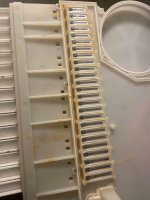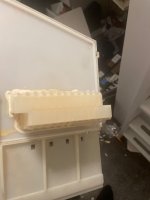Most of these early instruments were hi/lo boxes where the low reeds on the treble side were engaged or disengaged with a mechanical device (coupler) usually a palm switch on the back edge of the keyboard. On the top of the accordion I think I see a tan button that is likely the indicator to show if the low reeds set is engaged or not. So I think this is a hi/lo instrument and there should be a mechanic device to toggle between the two registrations.


